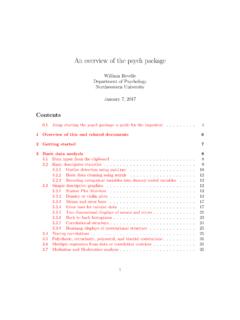Transcription of [CM] Choice Models - Stata
1 Stata Choice MODELSREFERENCE MANUALRELEASE 17 A Stata Press PublicationStataCorp LLCC ollege Station, Texas Copyrightc 1985 2021 StataCorp LLCAll rights reservedVersion 17 Published by Stata Press, 4905 Lakeway Drive, College Station, Texas 77845 Typeset in TEXISBN-10: 1-59718-325-3 ISBN-13: 978-1-59718-325-3 This manual is protected by copyright. All rights are reserved. No part of this manual may be reproduced, storedin a retrieval system, or transcribed, in any form or by any means electronic, mechanical, photocopy, recording, orotherwise without the prior written permission of StataCorp LLC unless permitted subject to the terms and conditionsof a license granted to you by StataCorp LLC to use the software and documentation.
2 No license, express or implied,by estoppel or otherwise, to any intellectual property rights is granted by this provides this manual as is without warranty of any kind, either expressed or implied, including, butnot limited to, the implied warranties of merchantability and fitness for a particular purpose. StataCorp may makeimprovements and/or changes in the product(s) and the program(s) described in this manual at any time and software described in this manual is furnished under a license agreement or nondisclosure agreement. The softwaremay be copied only in accordance with the terms of the agreement. It is against the law to copy the software ontoDVD, CD, disk, diskette, tape, or any other medium for any purpose other than backup or archival automobile dataset appearing on the accompanying media is Copyrightc 1979 by Consumers Union of ,Inc.
3 , Yonkers, NY 10703-1057 and is reproduced by permission from CONSUMER REPORTS, April ,, Stata Press, Mata,, and NetCourse are registered trademarks of StataCorp and Stata Press are registered trademarks with the World Intellectual Property Organization of the United is a trademark of StataCorp brand and product names are registered trademarks or trademarks of their respective copyright information about the software, typehelp copyrightwithin suggested citation for this software isStataCorp. : Release 17. Statistical Software. College Station, TX: StataCorp .. Introduction1 Intro 1 .. Interpretation of Choice models4 Intro 2 .. Data layout17 Intro 3 .. Descriptive statistics21 Intro 4.
4 Estimation commands27 Intro 5 .. Models for discrete choices32 Intro 6 .. Models for rank-ordered alternatives56 Intro 7 .. Models for panel data65 Intro 8 .. Random utility Models , assumptions, and estimation73cmchoiceset .. Tabulate Choice sets78cmclogit .. Conditional logit (McFadden s) Choice model87cmclogit postestimation .. Postestimation tools for cmclogit 103cmmixlogit .. Mixed logit Choice model 109cmmixlogit postestimation .. Postestimation tools for cmmixlogit 128cmmprobit .. Multinomial probit Choice model 132cmmprobit postestimation .. Postestimation tools for cmmprobit 160cmrologit .. Rank-ordered logit Choice model 166cmrologit postestimation .. Postestimation tools for cmrologit 184cmroprobit.
5 Rank-ordered probit Choice model 187cmroprobit postestimation .. Postestimation tools for cmroprobit 201cmsample .. Display reasons for sample exclusion 208cmset .. Declare data to be Choice model data 217cmsummarize .. Summarize variables by chosen alternatives 226cmtab .. Tabulate chosen alternatives 232cmxtmixlogit .. Panel-data mixed logit Choice model 242cmxtmixlogit postestimation .. Postestimation tools for cmxtmixlogit 260margins .. Adjusted predictions, predictive margins, and marginal effects 264nlogit .. Nested logit regression 289nlogit postestimation .. Postestimation tools for nlogit 313 Glossary ..318 Subject and author index ..319iCross-referencing the documentationWhen reading this manual, you will find references to other Stata manuals, for example,[U] 27 Overview of Stata estimation commands; [R]regress; and [D]reshape.
6 The first ex-ample is a reference to chapter 27,Overview of Stata estimation commands, in theUser s Guide;the second is a reference to theregressentry in theBase Reference Manual; and the third is areference to thereshapeentry in theData Management Reference the manuals in the Stata Documentation have a shorthand notation:[GSM]Getting Started with Stata for Mac[GSU]Getting Started with Stata for Unix[GSW]Getting Started with Stata for Windows[U] Stata User s Guide[R] Stata Base Reference Manual[BAYES] Stata Bayesian Analysis Reference Manual[CM] Stata Choice Models Reference Manual[D] Stata Data Management Reference Manual[DSGE] Stata Dynamic Stochastic General Equilibrium Models Reference Manual[ERM] Stata Extended Regression Models Reference Manual[FMM] Stata Finite Mixture Models Reference Manual[FN] Stata Functions Reference Manual[G] Stata Graphics Reference Manual[IRT] Stata Item Response Theory Reference Manual[LASSO] Stata Lasso Reference Manual[XT] Stata Longitudinal-Data/Panel-Data Reference Manual[META]
7 Stata Meta-Analysis Reference Manual[ME] Stata Multilevel Mixed-Effects Reference Manual[MI] Stata Multiple-Imputation Reference Manual[MV] Stata Multivariate Statistics Reference Manual[PSS] Stata Power, Precision, and Sample-Size Reference Manual[P] Stata Programming Reference Manual[RPT] Stata Reporting Reference Manual[SP] Stata Spatial Autoregressive Models Reference Manual[SEM] Stata Structural Equation Modeling Reference Manual[SVY] Stata Survey Data Reference Manual[ST] Stata Survival Analysis Reference Manual[TABLES] Stata Customizable Tables and Collected Results Reference Manual[TS] Stata Time-Series Reference Manual[TE] Stata Treatment-Effects Reference Manual:Potential Outcomes/Counterfactual Outcomes[ I ] Stata Index[M]Mata Reference ManualiiTitleIntro IntroductionDescriptionRemarks and examplesDescriptionChoice Models (CM) are Models for data with outcomes that are choices.
8 The choices are selectedby a decision maker, such as a person or a business, from a set of possible alternatives. For instance,we could model choices made by consumers who select a breakfast cereal from several differentbrands. Or we could model choices made by businesses who chose whether to buyTV, radio, Internet,or newspaper for Choice data come in two varieties Models for discrete choices and Models for rank-ordered alternatives. When each individual selects a single alternative, say, he or she purchases onebox of cereal, the data are discrete Choice data. When each individual ranks the choices, say, heor she orders cereals from most favorite to least favorite, the data are rank-ordered data. Stata hascommands for fitting both discrete Choice Models and rank-ordered manual documents commands for working with and summarizing Choice data, for fittingmodels, and for interpreting the results of those and examplesThe entries in this manual are organized as follows:IntroductionsDeclaring and summarizing dataFitting Choice modelsPostestimationGlossaryIntroduction sWe recommend that you read the introductions first.
9 In them, you will learn the language of choicemodels. We will show you how data for Choice Models are organized and how to explore these datausing special summary statistic commands. You will learn about the Models available for Choice dataand what makes each one unique. You will also learn about how to interpret results of these Models are known for being difficult to interpret, but Stata makes interpretation easy. So westart by telling you all about interpretation in the first introduction.[CM]Intro 1 Interpretation of Choice Models [CM]Intro 2 Data layout[CM]Intro 3 Descriptive statistics[CM]Intro 4 Estimation commands[CM]Intro 5 Models for discrete choices[CM]Intro 6 Models for rank-ordered alternatives[CM]Intro 7 Models for panel data[CM]Intro 8 Random utility Models , assumptions, and estimation12 Intro IntroductionDeclaring and summarizing dataBefore you fit a model with one of thecmcommands, you will need tocmsetyour data.
10 [CM]cmsetDeclare data to be Choice model dataYou can explore your data using the specialized commands for computing summary statistics forchoice model data.[CM]cmchoicesetTabulate Choice sets[CM]cmsampleDisplay reasons for sample exclusion[CM]cmsummarizeSummarize variables by chosen alternatives[CM]cmtabTabulate chosen alternativesFitting Choice modelsWhen you are ready to fit one of the Choice Models to your data, you can find information onsyntax, additional examples, and methods and formulas in the entry for the following commands fit Models for discrete choices:[CM]cmclogitConditional logit (McFadden s) Choice model [CM]cmmixlogitMixed logit Choice model [CM]cmmprobitMultinomial probit Choice model [CM]nlogitNested logit regressionThe following commands fit Models for rank-ordered alternatives.
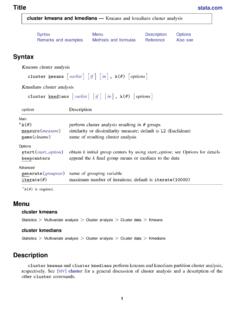
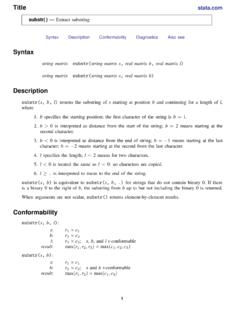
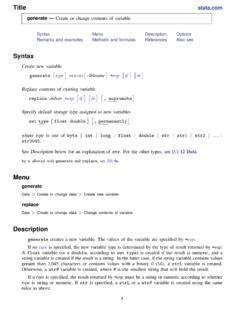
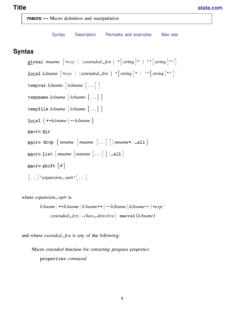
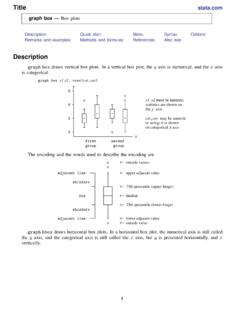
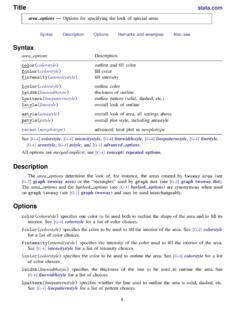
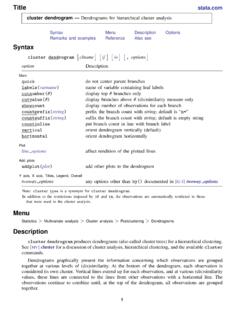
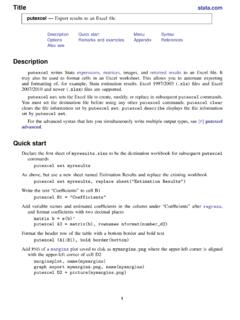
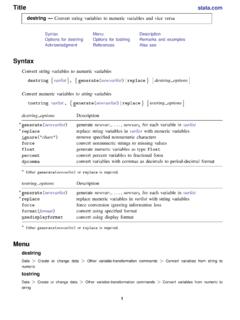
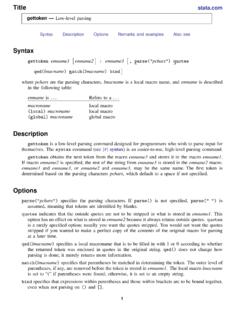
![[ME] Multilevel Mixed Effects - Stata](/cache/preview/4/7/d/4/7/0/c/8/thumb-47d470c861983dd93e6de78ee5724463.jpg)


